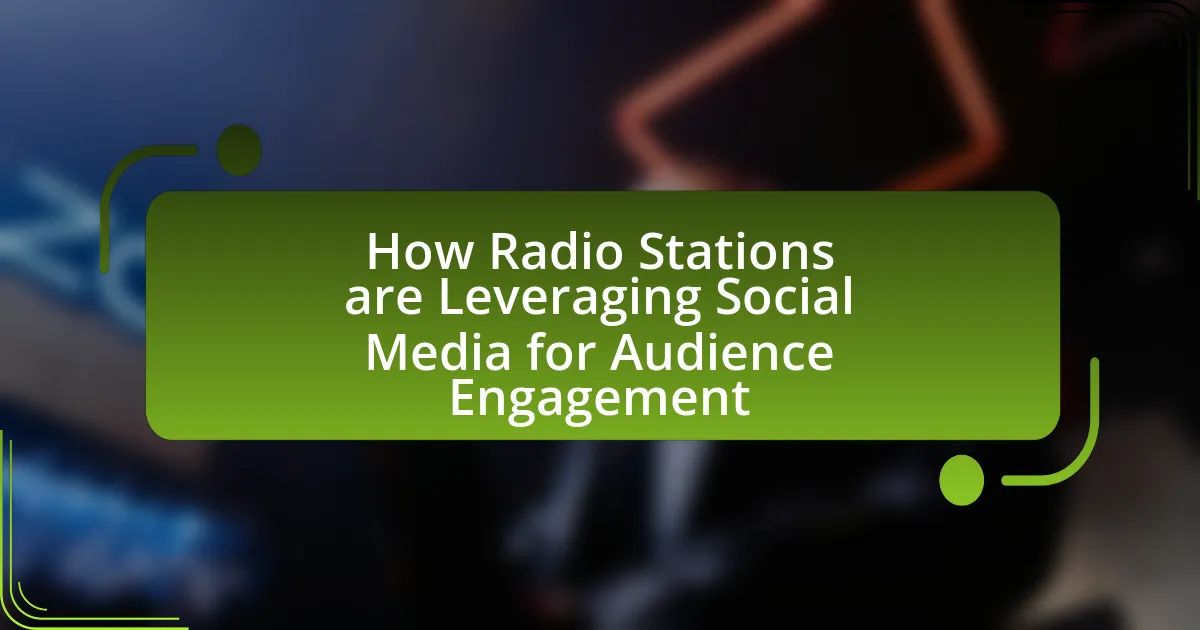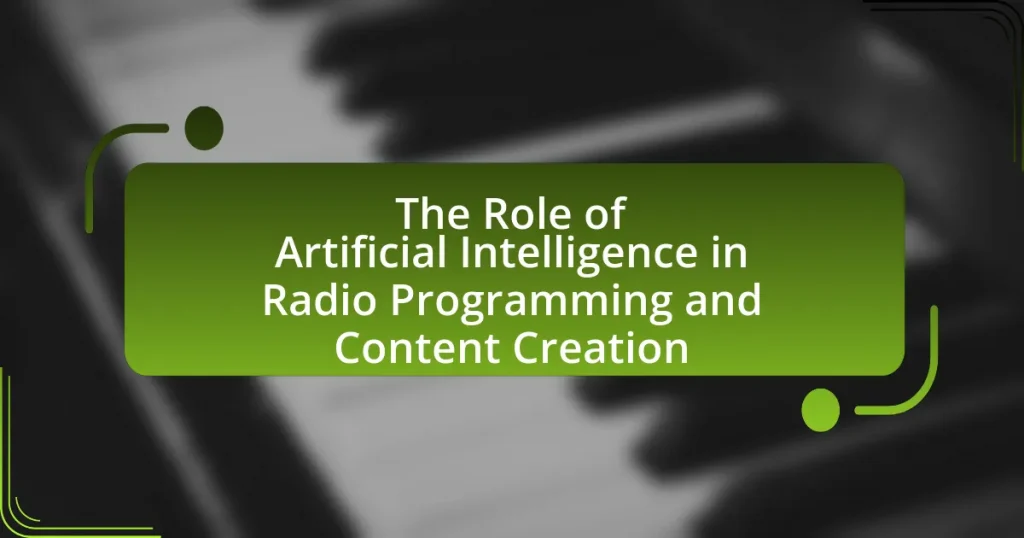Radio stations are increasingly leveraging social media platforms to enhance audience engagement through interactive content, community discussions, and event promotions. Key platforms such as Facebook, Instagram, and Twitter are utilized for real-time updates, listener feedback, and tailored content that caters to diverse demographics. The article explores effective strategies for engagement, the importance of analytics in measuring success, and the challenges faced by radio stations in navigating social media landscapes. Additionally, it highlights best practices for content creation, audience interaction, and the role of visuals in fostering listener loyalty.
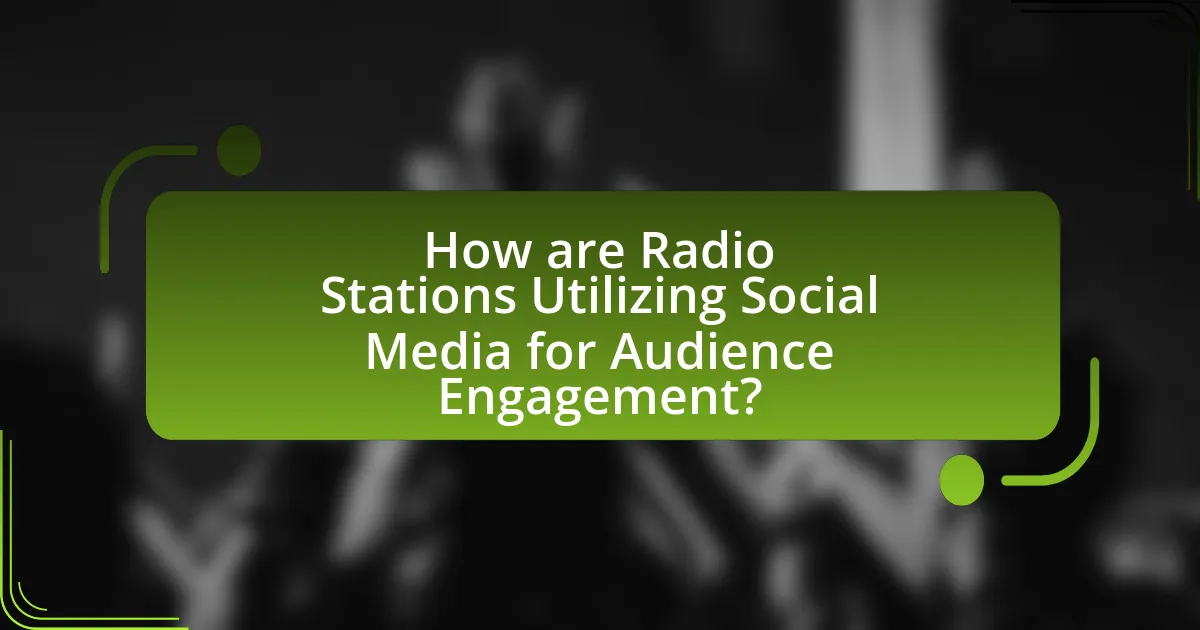
How are Radio Stations Utilizing Social Media for Audience Engagement?
Radio stations are utilizing social media to enhance audience engagement by creating interactive content, fostering community discussions, and promoting live events. For instance, stations often use platforms like Facebook and Twitter to host polls, share behind-the-scenes content, and encourage listener feedback, which increases listener participation. According to a 2022 survey by the Radio Advertising Bureau, 70% of radio listeners engage with their favorite stations on social media, indicating a strong correlation between social media activity and audience loyalty. Additionally, radio stations leverage social media for real-time updates and announcements, further solidifying their connection with listeners.
What social media platforms are most effective for radio stations?
The most effective social media platforms for radio stations are Facebook, Instagram, and Twitter. These platforms enable radio stations to engage with their audience through live updates, interactive content, and community building. For instance, Facebook’s extensive user base allows stations to reach a diverse audience, while Instagram’s visual focus helps in promoting events and shows effectively. Twitter facilitates real-time interaction and updates, making it ideal for sharing news and engaging listeners during broadcasts. According to a 2022 survey by the Pew Research Center, 69% of adults in the U.S. use Facebook, highlighting its potential reach for radio stations.
How do different platforms cater to various audience demographics?
Different platforms cater to various audience demographics by tailoring content, features, and engagement strategies to meet the preferences and behaviors of specific user groups. For instance, Facebook targets a broad age range, offering community-building tools that appeal to older demographics, while TikTok focuses on younger audiences with short, engaging video content that emphasizes trends and creativity. Additionally, platforms like LinkedIn cater to professionals by providing networking opportunities and industry-specific content, which attracts a more career-oriented demographic. Research indicates that 60% of TikTok users are aged 16-24, highlighting its appeal to younger audiences, whereas Facebook remains popular among users aged 25-34, according to Pew Research Center data.
What unique features do platforms like Instagram and Twitter offer for engagement?
Instagram offers unique features such as Stories, which allow users to share temporary content that disappears after 24 hours, fostering real-time engagement and interaction. Additionally, Instagram’s visual-centric platform encourages creative content through images and videos, enhancing user engagement through likes, comments, and shares. Twitter, on the other hand, provides features like retweets and hashtags, enabling users to amplify their messages and participate in trending conversations, which increases visibility and engagement. Both platforms utilize algorithms that prioritize engaging content, further driving user interaction.
Why is social media important for radio stations today?
Social media is important for radio stations today because it enhances audience engagement and expands reach. By utilizing platforms like Facebook, Twitter, and Instagram, radio stations can interact with listeners in real-time, share content, and promote events, which fosters a sense of community. According to a Nielsen report, 60% of radio listeners engage with stations on social media, indicating that these platforms are crucial for maintaining listener loyalty and attracting new audiences. Additionally, social media allows radio stations to gather feedback and insights from their audience, enabling them to tailor content more effectively to listener preferences.
How does social media enhance listener interaction and feedback?
Social media enhances listener interaction and feedback by providing real-time communication channels between radio stations and their audiences. Platforms like Twitter and Facebook allow listeners to share their thoughts instantly, enabling stations to receive immediate feedback on programming and content. For instance, a study by the Pew Research Center found that 69% of adults in the U.S. use social media, which facilitates direct engagement through comments, likes, and shares, fostering a sense of community. This interaction not only helps stations gauge listener preferences but also encourages audience participation in polls and contests, further enriching the feedback loop.
What role does social media play in brand building for radio stations?
Social media plays a crucial role in brand building for radio stations by enhancing audience engagement and expanding reach. Through platforms like Facebook, Twitter, and Instagram, radio stations can interact directly with listeners, share content, and promote events, which fosters a sense of community and loyalty among their audience. For instance, a study by the Pew Research Center found that 72% of adults use social media, making it an effective channel for radio stations to connect with a broader demographic. Additionally, social media allows for real-time feedback and interaction, enabling stations to adapt their content based on listener preferences, thereby strengthening their brand identity and relevance in a competitive market.
What strategies are radio stations employing on social media?
Radio stations are employing strategies such as interactive content, live streaming, and audience engagement through polls and contests on social media. These strategies enhance listener interaction and foster community building. For instance, radio stations often use platforms like Instagram and Facebook to host live Q&A sessions, allowing listeners to connect directly with hosts and artists. Additionally, they utilize polls to gather listener preferences, which can inform programming decisions and create a sense of involvement. According to a 2022 survey by the Radio Advertising Bureau, 70% of radio stations reported increased listener engagement through social media initiatives, demonstrating the effectiveness of these strategies in reaching and retaining audiences.
How do radio stations create engaging content for their audiences?
Radio stations create engaging content for their audiences by utilizing interactive elements, social media integration, and audience feedback mechanisms. They often host live call-in segments, allowing listeners to participate directly, which fosters a sense of community and involvement. Additionally, radio stations leverage social media platforms to share behind-the-scenes content, promote upcoming shows, and engage with listeners through polls and contests. This approach not only enhances listener interaction but also provides valuable insights into audience preferences, enabling stations to tailor their programming effectively. Research indicates that stations that actively engage with their audience on social media see increased listener loyalty and higher ratings, demonstrating the effectiveness of these strategies in creating compelling content.
What are the best practices for live interactions on social media?
The best practices for live interactions on social media include engaging with the audience in real-time, responding promptly to comments, and using interactive features such as polls and Q&A sessions. Engaging with the audience fosters a sense of community and encourages participation, which is crucial for radio stations aiming to enhance audience engagement. Responding promptly to comments demonstrates attentiveness and values audience input, leading to increased loyalty. Utilizing interactive features, such as polls, allows for immediate feedback and keeps the audience involved, which has been shown to increase viewer retention and satisfaction. These practices are supported by studies indicating that real-time engagement can significantly boost audience interaction rates and overall satisfaction with the content provided.
How do radio stations measure the success of their social media efforts?
Radio stations measure the success of their social media efforts primarily through engagement metrics, such as likes, shares, comments, and follower growth. These metrics provide insights into audience interaction and content resonance. For example, a study by the Pew Research Center found that 69% of adults in the U.S. use social media, indicating a significant platform for audience engagement. Additionally, radio stations often track website traffic originating from social media channels, using tools like Google Analytics to assess how social media campaigns drive listeners to their websites or streaming services. This data helps stations refine their strategies and improve audience connection.
What metrics are most relevant for evaluating audience engagement?
The most relevant metrics for evaluating audience engagement include likes, shares, comments, reach, and engagement rate. Likes indicate the immediate approval of content, while shares reflect the content’s virality and ability to resonate with the audience. Comments provide qualitative insights into audience sentiment and interaction. Reach measures how many unique users have seen the content, and engagement rate, calculated as the total engagement divided by total followers, offers a comprehensive view of how effectively the audience interacts with the content. These metrics collectively provide a clear picture of audience engagement levels and content effectiveness in the context of radio stations leveraging social media.
How can radio stations use analytics to improve their social media strategies?
Radio stations can use analytics to improve their social media strategies by analyzing audience engagement metrics to tailor content effectively. By tracking data such as likes, shares, comments, and demographic information, radio stations can identify which types of posts resonate most with their audience. For instance, a study by Nielsen found that 70% of consumers are more likely to engage with brands that personalize their content based on user behavior. This data-driven approach allows radio stations to refine their messaging, optimize posting times, and enhance overall audience interaction, ultimately leading to increased listener loyalty and engagement.
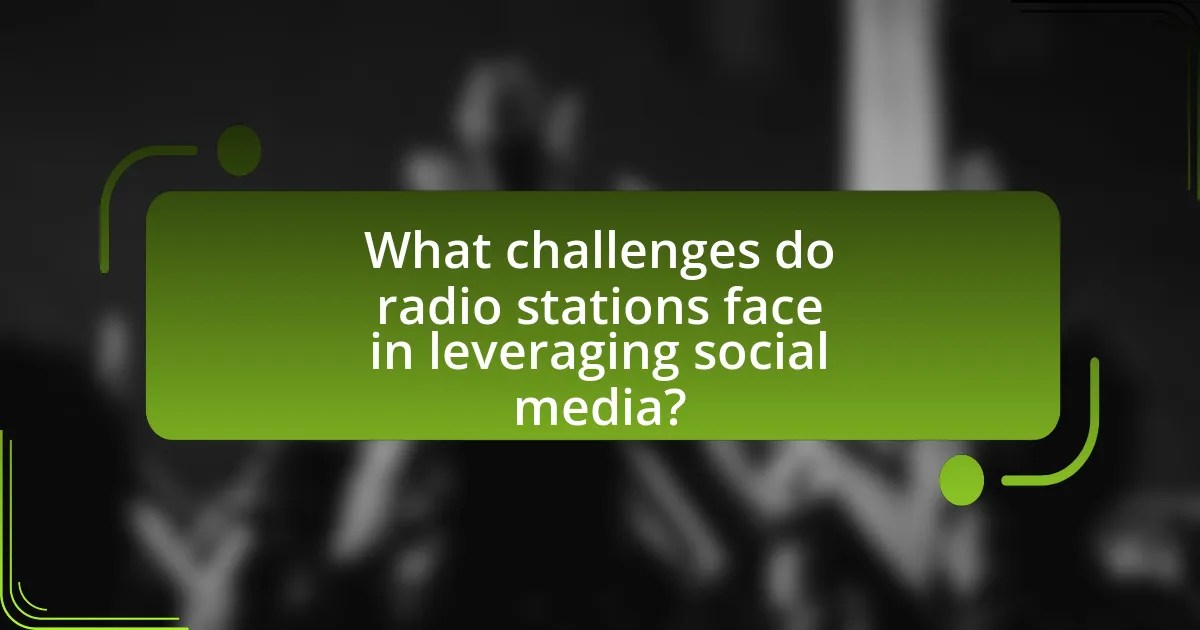
What challenges do radio stations face in leveraging social media?
Radio stations face several challenges in leveraging social media, primarily including resource constraints, audience fragmentation, and content strategy difficulties. Resource constraints arise from limited staff and budget, which hinder the ability to create and manage engaging social media content effectively. Audience fragmentation complicates targeting, as listeners are dispersed across various platforms, making it difficult for radio stations to reach their entire audience consistently. Additionally, developing a coherent content strategy that aligns with both on-air programming and social media engagement poses a significant challenge, as radio stations must balance promotional content with interactive and entertaining posts to maintain listener interest.
How do changing algorithms impact radio station visibility?
Changing algorithms significantly impact radio station visibility by altering how content is prioritized and displayed on social media platforms. For instance, when platforms like Facebook or Instagram update their algorithms to favor video content over audio, radio stations may experience decreased engagement and reach if they do not adapt their content strategy accordingly. A study by the Pew Research Center found that 69% of adults in the U.S. use social media, highlighting the importance of these platforms for visibility. Consequently, radio stations must continuously adjust their content formats and engagement strategies to align with algorithm changes, ensuring they maintain or enhance their visibility in a competitive digital landscape.
What strategies can radio stations use to adapt to algorithm changes?
Radio stations can adapt to algorithm changes by diversifying their content distribution strategies across multiple social media platforms. This approach allows them to reach a broader audience and mitigate the impact of any single platform’s algorithm adjustments. For instance, by utilizing platforms like Instagram, Twitter, and TikTok alongside traditional broadcasting, radio stations can engage listeners through varied content formats, such as live streams, behind-the-scenes videos, and interactive polls.
Additionally, radio stations can analyze audience engagement metrics to tailor their content more effectively, ensuring that they remain relevant despite algorithm shifts. Research indicates that stations that actively monitor listener preferences and adapt their programming accordingly see increased audience retention and growth. By implementing these strategies, radio stations can maintain their listener base and enhance audience engagement in a rapidly changing digital landscape.
How can radio stations overcome audience fragmentation on social media?
Radio stations can overcome audience fragmentation on social media by creating targeted content that resonates with specific audience segments. By analyzing listener demographics and preferences, stations can tailor their social media posts to engage different groups effectively. For instance, a study by the Pew Research Center found that 72% of adults use social media, indicating a vast potential audience. Additionally, utilizing interactive features such as polls, live Q&A sessions, and user-generated content can foster community engagement and loyalty among diverse listener groups. This approach not only enhances audience connection but also encourages sharing, which can amplify reach and reduce fragmentation.
What are the potential pitfalls of social media engagement for radio stations?
The potential pitfalls of social media engagement for radio stations include mismanagement of brand image, negative audience interactions, and resource allocation challenges. Mismanagement of brand image can occur when stations fail to maintain a consistent voice or respond inappropriately to audience comments, leading to public relations issues. Negative audience interactions, such as trolling or backlash from controversial posts, can damage listener relationships and trust. Additionally, resource allocation challenges arise when stations invest significant time and effort into social media without clear strategies or measurable outcomes, potentially diverting attention from core broadcasting activities. These pitfalls highlight the need for careful planning and execution in social media strategies.
How can negative feedback be managed effectively on social media?
Negative feedback on social media can be managed effectively by promptly acknowledging the concerns raised and responding with empathy. This approach demonstrates that the radio station values listener opinions and is committed to addressing issues. Research indicates that 70% of consumers are more likely to recommend a brand that responds to their feedback, highlighting the importance of engagement in maintaining a positive relationship with the audience. Additionally, providing clear solutions or follow-up actions can help mitigate dissatisfaction and foster trust.
What legal considerations should radio stations be aware of when using social media?
Radio stations must be aware of copyright laws, defamation risks, and privacy regulations when using social media. Copyright laws protect original content, requiring radio stations to obtain permission for music, images, or videos they share. Defamation risks arise if false statements about individuals or organizations are made, potentially leading to legal action. Privacy regulations, such as the General Data Protection Regulation (GDPR) in Europe, mandate that radio stations handle personal data responsibly, ensuring they have consent before collecting or sharing user information. These legal considerations are crucial for maintaining compliance and protecting the station from potential lawsuits.
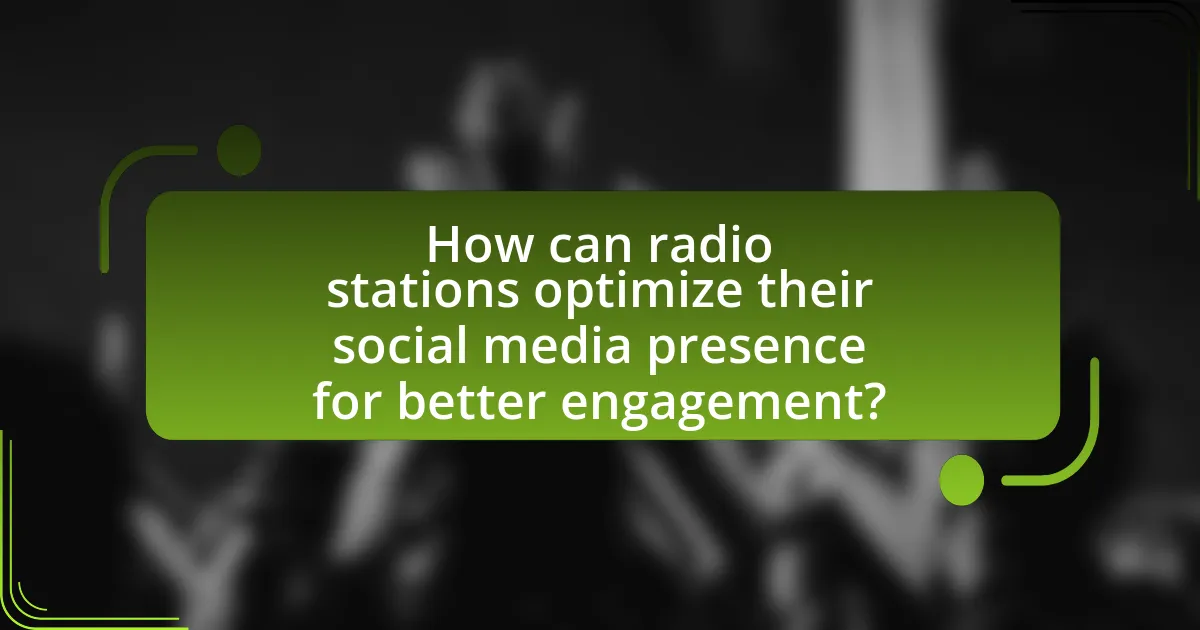
How can radio stations optimize their social media presence for better engagement?
Radio stations can optimize their social media presence for better engagement by creating interactive content that encourages audience participation. This includes hosting live Q&A sessions, polls, and contests that invite listeners to share their opinions and experiences. According to a study by the Pew Research Center, 69% of adults in the U.S. use social media, making it a vital platform for reaching and engaging with audiences. Additionally, utilizing analytics tools to track engagement metrics allows radio stations to refine their strategies based on what content resonates most with their audience, thereby enhancing overall interaction and loyalty.
What content types resonate most with radio station audiences?
Music-related content resonates most with radio station audiences. This includes live performances, artist interviews, and curated playlists that reflect listener preferences. According to a Nielsen report, 63% of radio listeners engage with music content, highlighting its significance in audience retention and engagement. Additionally, interactive content such as contests and listener polls also proves effective, as they foster a sense of community and participation among listeners.
How can storytelling enhance audience connection on social media?
Storytelling enhances audience connection on social media by creating relatable and engaging narratives that resonate with users. When radio stations share personal stories, behind-the-scenes content, or listener experiences, they foster emotional connections that encourage audience interaction. Research indicates that emotional storytelling can increase engagement rates by up to 300%, as it prompts users to share and comment, thereby amplifying reach and community building. This approach not only humanizes the brand but also cultivates loyalty among listeners, making them feel like part of a shared experience.
What role do visuals play in social media engagement for radio stations?
Visuals significantly enhance social media engagement for radio stations by capturing audience attention and conveying messages more effectively. Research indicates that posts with images receive 94% more views than those without, highlighting the importance of visual content in attracting listeners. Additionally, visuals can create a stronger emotional connection, as studies show that people process images 60,000 times faster than text, making them more likely to engage with the content. This increased engagement can lead to higher listener interaction, sharing, and overall brand loyalty for radio stations.
What are some best practices for radio stations on social media?
Radio stations should prioritize consistent and engaging content on social media to effectively connect with their audience. This includes regularly posting updates about shows, sharing behind-the-scenes content, and interacting with listeners through comments and messages. Engaging with followers can increase listener loyalty and expand reach, as social media platforms often reward active accounts with greater visibility. According to a study by the Pew Research Center, 69% of adults in the U.S. use social media, highlighting the importance of these platforms for audience engagement. Additionally, utilizing multimedia content such as videos and live streams can enhance engagement, as visual content tends to attract more interaction.
How can radio stations effectively schedule their posts for maximum reach?
Radio stations can effectively schedule their posts for maximum reach by analyzing audience engagement data to identify peak activity times. Research indicates that social media platforms experience higher user engagement during specific hours, typically during lunch breaks and evenings, which can vary by demographic. For instance, a study by Sprout Social found that the best times to post on Facebook for maximum engagement are Wednesdays at 11 a.m. and Fridays from 10 a.m. to 11 a.m. By aligning their posting schedule with these peak times, radio stations can enhance visibility and interaction with their audience. Additionally, utilizing social media management tools allows for automated scheduling, ensuring consistent posting without manual intervention, further optimizing reach.
What tools can assist radio stations in managing their social media accounts?
Radio stations can utilize tools such as Hootsuite, Buffer, and Sprout Social to effectively manage their social media accounts. Hootsuite allows for scheduling posts across multiple platforms, monitoring engagement, and analyzing performance metrics, which is essential for maintaining an active online presence. Buffer offers similar functionalities, enabling users to plan and publish content while providing insights into audience interactions. Sprout Social enhances these capabilities with advanced analytics and social listening features, helping radio stations understand audience sentiment and trends. These tools collectively streamline social media management, making it easier for radio stations to engage with their audience effectively.
What tips can radio stations implement to enhance audience engagement on social media?
Radio stations can enhance audience engagement on social media by creating interactive content, such as polls and quizzes, which encourage audience participation. This approach not only fosters a sense of community but also provides valuable insights into listener preferences. According to a study by the Pew Research Center, 69% of adults in the U.S. use social media, indicating a significant opportunity for radio stations to connect with their audience through these platforms. Additionally, sharing behind-the-scenes content and live updates can humanize the station and build a stronger connection with listeners, as evidenced by increased follower engagement rates reported by various media outlets.
